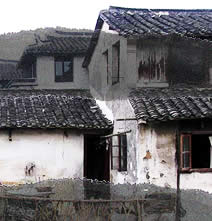|
1. Twin Bridges
Zhouzhuang's Twin Bridges comprise an arched bridge, Shide, and a beam bridge, Yongan. Together, Shide and Yongan form one of the town's more popular attractions.
They meet at a right angle, and their complementary shapes create the image of an ancient Chinese key, which is why Shide and Yongan are also known to the locals as Key Bridges. These bridges were constructed during the Wanli years (1573-1619) of the Ming Dynasty. Shide is 16 meters in length, 3 meters in width, and has a bridge span of 5.9 meters. Yongan is 13.3 meters long, 2.4 meters wide, with a span of 3.5 meters.
Shide arches over a stream that runs north to south through the town. The steps at its eastern end extend well into a lane connecting to it. Yongan, sitting at the mouth of the Silver Creak, only allows small boats to pass through its opening.
In 1984, one of China's most respected oil painters, Chen Yifei painted his masterpiece, Memory of My Hometown, of the Twin Bridges. The painting was first displayed in a gallery in New York owned by Armand Hammer, president of the US Occidental Petroleum Corporation. Hammer bought the work at a high price and presented it to the then Chinese leader Deng Xiaoping during a visit to China later that year. In 1985, the work was chosen by the United Nations to be one of its first day covers.
2. Fu'an Bridge
A unique feature of Fu’an Bridge is the four structures built at each corner of the bridge. The body of the bridge was built with Jinshan granite, and the railings and the steps on both ends were made of Wukang stones. Auspicious patterns carved out on the bridge floor, and the towers' upturned eaves give the bridge an impressive air.
3. Zhang's Compound
Zhang's Compound, one of the few existing buildings dating back to the Ming Dynasty, is one of Jiangsu's protected historical sites. This 500-year-old residence has kept much of its original splendor thanks to careful maintenance in recent years.
The compound comprises six courtyards, and has over 70 rooms. The complex occupies an area of over 1,800 square meters. Setting foot into the compound, one is greeted by two-storied buildings that flank either side of the main gate, and the awesome sight of the very spacious Jade-Swallow Hall, the centerpiece of the compound. This structure’s Ming style is most strikingly found with its big pillars standing on the jar-shaped stone bases.
Running below Jade Swallow Hall is a stream, a section of which resembles a 3-sq-yd cistern. Small boats can berth here. In fact, there is a verse of an old poem that reads, “Little boats pass through home.”
4. Shen's Compound
The 2,000-sq-m compound is located on Nanshi Street, near the southern end of Fu’an Bridge. The compound boasts seven courtyards and some 100 rooms. The interesting feature of Shen's Compound is its symmetrical design. If one were to draw a line right through the center of the compound, one would find that the two halves on either side of that line are identical. This heritage home was built during the Qing Dynasty, in 1742 – the seventh year of Emperor Qianlong's reign.
The set-up of the compound is typical of those belonging to wealthy families at that time. The front part of the complex consists of waterfront arches and docks, where private boats could berth and the laundry done. The middle part of the residence has an arched gateway, a tea hall and a lounge. This is where family events were normally held – wedding parties, funerals and household meetings. The living quarters were to the back of the compound.
5. Milou Restaurant
The restaurant's original name was Deji after its first owner, Li Defu, who was a chef de cuisine from Zhenjiang, Jiangsu. He moved to Zhouzhuang with his family in the late 19th century and, the rest, as they say, is history.
6. Quanfu Temple
This Buddhist temple is as old as Zhouzhuang itself. In fact, the name "Zhouzhuang" is somewhat related to the temple. Zhouzhuang used to be known as Fufengli. In 1086, the aristocrat Zhou Di donated 13 hectares of his land to build the temple. To show their gratitude for Zhou's generosity, the townsfolk decided to rename the town after Zhou. Quanfu Temple is one of southeastern China's more famous temples. A five-fold courtyard rolls into a magnificent main hall where a 10-meter-high statue of the Buddha sits serenely in the middle of the hall. The statue is so huge that a person could lie comfortably in its upturned palm.
|







